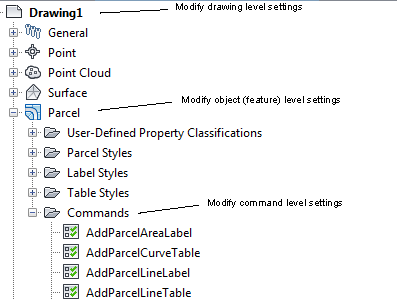Use a standard dialog box, accessed at three different levels, to edit settings.
You modify each level of settings at a different location in the Settings tree, as shown in the following illustration:

Drawing-Level Settings
There are two types of drawing-level settings:
- Drawing-wide settings, which include units and zone, transformation settings, abbreviations, and object layers.
- Ambient settings, which affect a variety of AutoCAD Civil 3D behaviors. You can change ambient settings at the drawing level, and you can also override ambient setting values at either the object level or the command level.
You access drawing-level settings by right-clicking the drawing name in the Settings tree and clicking .
At the drawing level, the Edit Settings dialog box contains only the ambient settings for the drawing:

Object(Feature)-Level Settings
Use the object collection level in the Settings tree to control all settings that pertain to the object type. Change the object settings at this level in the tree, and specify overrides for the drawing ambient settings.
Access the object- or feature-level settings by right-clicking the object collection in the Settings tree and clicking .
At the object level, this dialog box also contains object-specific settings, such as default styles, which are listed below the General settings:

Command-Level Settings
Use the Commands collection level in the Settings tree to override both the object-level settings and drawing ambient settings on a command-by-command basis. You can also specify command-specific settings.
Access the command-level settings by expanding the Commands collection for an object type in the Settings tree, right-clicking the command, and clicking .
At the command level, this dialog box also contains command-specific settings, such as the Parcels and Alignments settings that are used by the CreateSite command.

The following summarizes the controls in the Edit Settings dialog box:
- Use the + or – boxes to display or hide the settings in the category.
- Use the Value column to specify a value for a setting.
- The Override column indicates that the default value has been changed for the setting.
- The Child Override column indicates whether the setting has been overridden at a lower level in the Settings tree.
- Use the Lock column to control whether a setting can be changed at a lower level in the Settings tree.